Curry powder is a blend of spices that come together to give a warm and robust flavor to whatever dish it is used in.
Traditional Indian curries get their flavor from whole spices that are toasted and ground as needed for cooking (and vary depending on the dish). But, our simple homemade curry powder is an easy way to have easy, instant access to a great starting place for curry flavor. And it uses spices that you probably already have in your pantry!
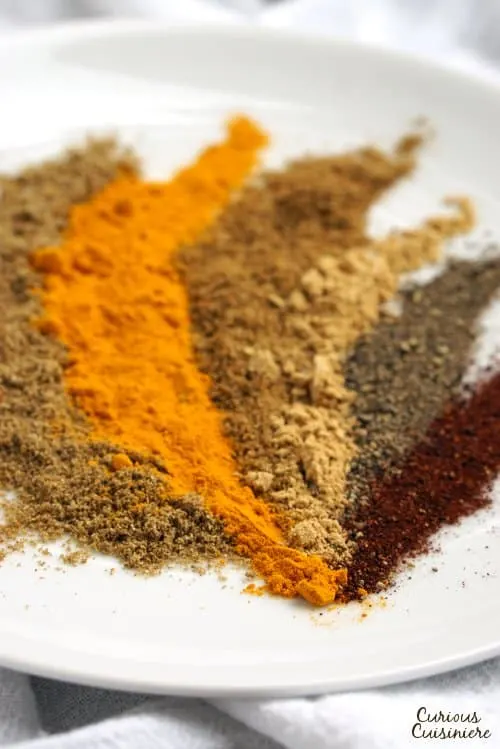
Is curry powder Indian?
You’ve probably seen jars of curry powder in the spice aisle and figured this mix was essential in creating Indian dishes. The interesting thing is that you won’t find curry powder in India.
The concept of “curry powder’” is actually a Bristish invention by the Indian spice merchants. It was an attempt to bring the flavor of Indian dishes that British colonists came to love home.
Where does the term “curry” come from?
In fact, the term “curry” is a British take on the Tamil word “kari” which refers to meat.
From the British colonizers to American useage, the word curry has now become common to describe many types of seasoned dishes with South Asian origin.
Really, the term “curry” could be used as a substitute for the word “masala” which means a “mix of spices”.
All Indian dishes start start with a specific masala (spice mix). These mixes can vary from region to region and household to household, as well as from dish to dish.
What is curry powder?
The spice blend that the British created was loosely based on the North Indian spice mix garam masala.
As the mix became popular in America, unfortunately, “curry powder” became synonymous with Indian curry, which is quite a misrepresentation of the vast array of Indian curries and flavors that they bring.
However, a pantry curry powder is a great way to easily lend some Indian-inspired flavors to your cooking.
As we dive into the possible ingredients below, you will see that the list is quite varied, which will hopefully encourage you to try adding some new spices to your curry powder, or try out a curry that uses toasted spices.
What are the ingredients in curry powder?
Since the term “curry” is so general and not well defined, you will find the spice mixture used to make up a “standard” curry powder differs greatly from jar to jar.
In India, each family has their own preference for how they put spices together for their masalas.
Think about it like the way an Italian Grandmother would season her meatballs or pasta sauce. There’s no ONE gold standard Italian recipe for either of those. The flavors will vary from region to region and chef to chef.
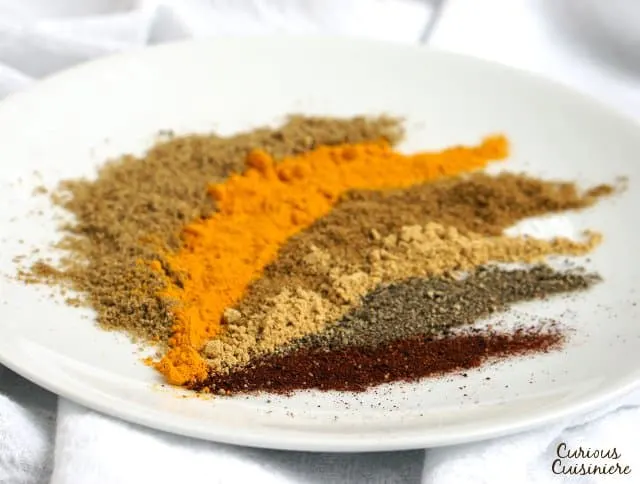
Most curry powder recipes do include a few common ingredients:
- coriander
- turmeric
- cumin
- chili peppers
Other spices that could be added are:
- fenugreek
- ginger
- garlic
- fennel
- caraway
- cinnamon
- clove
- mustard
- nutmeg
- black pepper
And the list goes on.
Each region in India, each family, and each dish have their own twist on what spices are commonly used. While you won’t find ALL of these spices in any one Indian masala, they appear in different combinations throughout the country.
As you can see, once you have the basics, there are SO MANY ways you could tweak your own curry powder recipe to make it your own.
How to make homemade curry powder from scratch
Traditionally, a masala (spice mix) is made by first toasting whole spices. Toasting releases some of the oils in the spices and makes the mixture more fragrant.
The toasted and cooled spices are then ground finely in to a powder or pounded into a paste and then used for the day’s dish.
Typically, this spice mixture is made fresh for each dish. That way, Indian chefs and home cooks really aren’t tied to any one flavor combination. (Like a set “Italian seasoning blend”.) They can vary the flavors, sweetness, heat, and so on, of their curry powder spice mix depending on what flavors they are looking for in their dish.
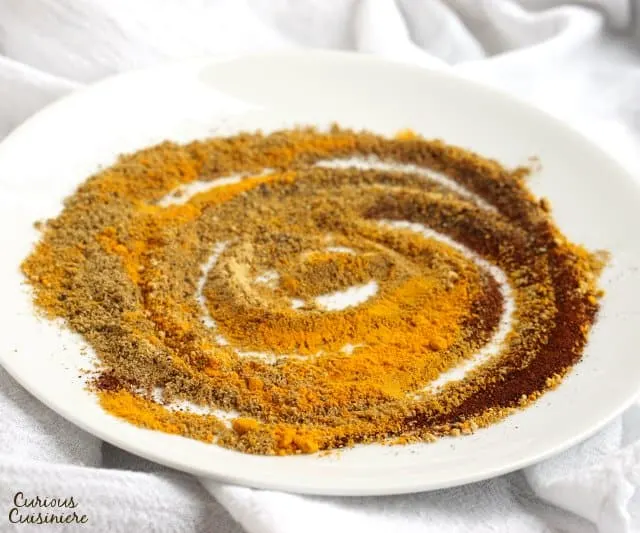
Our easy homemade curry powder recipe
While toasting whole spices and grinding them fresh for each recipe will give you the most fragrant and flavorful curry powder, sometimes you just want easy access to curry powder, without the extra steps.
Our goal with today’s recipe is to give you a recipe you can have pre-mixed, on-hand to make your weeknight-cooking easier.
We chose ingredients for our curry powder that you probably already have in your pantry.
- coriander
- cumin
- turmeric
- black pepper
- chili powder
- ginger
We take a shortcut and use each of these spices in their already ground form, so all you have to do is mix them together.
Seriously, we told you this curry powder was really easy to make!
(As a side note, you can always purchase these spices in their whole, dried form, lightly toast them over medium-low heat in a dry pan until fragrant, let them cool, then grind them.)
Substituting ingredients in this curry powder
If you do find yourself wanting a bit of a different flavor in your curry powder, feel free to use our recipe as a springing off point.
Add some of the other ingredients we mentioned earlier. Whichever sound like they’ll go well with the dish you’re making.
With this easy curry powder recipe, making curry powder isn’t much of a commitment at all. So you can add a pinch of this and a dash of that and not have to worry about re-toasting and re-grinding small additions of spices as you find your perfect curry powder.
(Or, find your perfect blend using the ground spices and then give your blend a try using whole spices. See what you think of the flavor difference between pre-ground and whole.)
How to store homemade curry powder
You will want to store your homemade curry powder in a glass jar with a well-fitting lid, in the pantry, away from heat and moisture.
Using pre-ground spices it will stay fresh for about 1-2 months. After that it will still be good, but you may notice that the flavor isn’t quite as strong.
If you decide to use whole spices and grind them yourself, your mixture will store for a bit longer (2-3 months) before it starts to slowly lose flavor intensity.
What is the difference between curry powder and garam masala?
Garam masala and curry powder are both spice blends that are often called for in Indian recipes. However, garam masala is a spice blend that is used in many traditional Indian kitchens, while curry powder (like we discussed above) is not.
Garam masala means ‘hot spice’, its name comes not from heat, but from the warming nature of the spices.
It does not include turmeric (like curry powder does), and so is more brown in color.
It does include spices like coriander, cumin, black pepper (similar to curry powder) along with cinnamon, cardamom, and cloves which give it a more sweet flavor.
Garam masala is added to the end of cooking to give warm flavor to the dish. (Curry powder is typically added towards the beginning of cooking.)
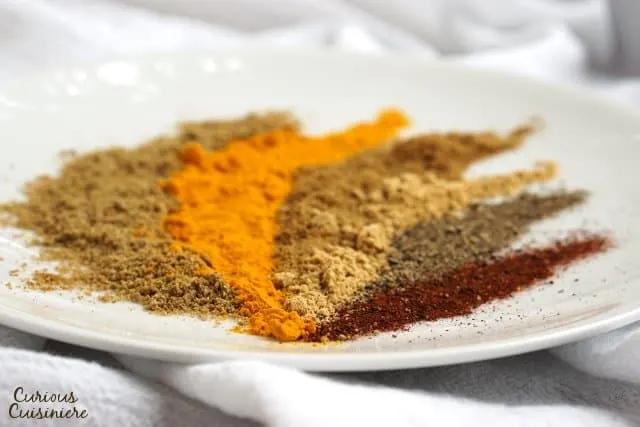
How to use curry powder
Curry powder is truly a unique combination of spices. It’s slightly sweet, slightly savory, quite earthy, with a bit of heat.
The nice thing about curry is that you can use pretty much anything you have on hand to make a delicious curry. Here are some of our favorite, easy curry recipes:
- Cauliflower and winter squash curry
- Paneer and potato curry
- Kenyan coconut chicken curry
- Curried chickpeas
- Singapore noodles
- Shri Lankan chicken curry
You also use curry powder in South African dishes like bobotie and bunny chow.
And, you can’t talk about curry powder without mentioning the classic German take on curry: currywurst!
So the next time you find yourself craving curry with no curry powder in sight, don’t worry. Just whip up a quick batch of this easy curry powder!
Easy Homemade Curry Powder (Small Batch)
Ingredients
- 1 Tbsp ground coriander seeds
- 1 ½ tsp cumin
- 1 tsp turmeric
- ½ tsp ground black pepper
- ½ tsp chili powder
- ½ tsp ground ginger
Instructions
- In a small bowl, mix all the ground spices.
- Use immediately, or store in an air-tight container in a cool, dry place for up to 2 months.
Notes
If you liked this recipe, here are some similar dishes you may enjoy!

Sarah founded Curious in 2010 as a way to save her recipe creations and share culinary experiences. Her love for cultural cuisines was instilled early by her French Canadian Grandmother. Her experience in the kitchen and in recipe development comes from over 10 years working in professional kitchens. She has traveled extensively and enjoys bringing the flavors of her travels back to create easy-to-make recipes.
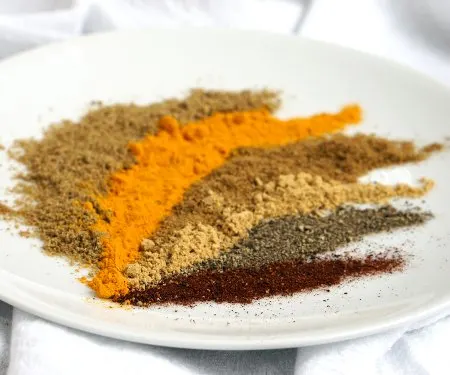
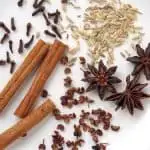
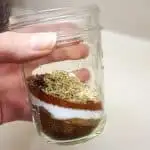
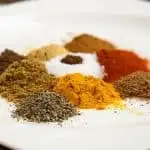
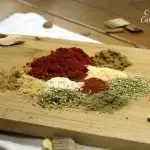
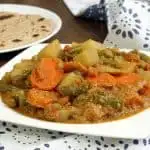
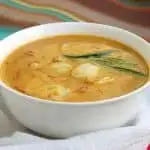
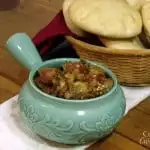
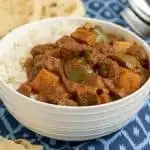
Louise
Friday 15th of August 2025
Hi, I read through this page with a lot of interest. Thank you for all this info. And I love your newsletters. I already make my own Garam Masala and curry would be a great addition to my pantry. I am French Canadian and I often have to stop myself while interpreting ingredient list. Many that we don't have access to here. That being said, I am questioning the use of the term ''Chili powder'' in your ingredients list. With one ''L'' chili means the dish of meat, beans and tomatoes. Chilli with too ''L'' I understood it as being the blend of peppers, spices and herbs. While CHILE is a powdered form of one ingredient only namely peppers. My guess is in this particular case you meant Chile and not Chili.
Sarah - Curious Cuisiniere
Wednesday 17th of September 2025
Thank you for your comment Louise! The spellings of that category of hot peppers varies, and it's often regional. According to Merriam-Webster dictionary, chili is common in American English, chilli in British English, and chile in Spanish speaking regions.
John
Tuesday 29th of July 2025
Will definitely be trying this, thanks Sarah
Sarah - Curious Cuisiniere
Wednesday 17th of September 2025
We hope you enjoy it!
Jonas
Wednesday 7th of February 2024
For me personally the balance was off.
Sarah - Curious Cuisiniere
Tuesday 13th of February 2024
Thank you for sharing Jonas. Curry powder is a very adaptable seasoning and everyone has their own tastes. If you read the article, you may find some ideas of how to adapt it to your tastes.
Margaret
Sunday 22nd of October 2023
I was in the middle of making a recipe that called for curry and saw that I had run out. Your recipe was easy and saved the day. Thank you!
Sarah - Curious Cuisiniere
Monday 23rd of October 2023
We're so glad you found us!
Rob
Sunday 9th of July 2023
Nice, easy recipe. Im an experienced cook, but, at home, i dont always want a huve production. Just quick, flavorful and straigtforward. For the average home cook, your family will love it. Make plenty of rice. The aromas and flavor will have mouths watering long before meal time. Pick up some NAN to have with it. Very nice recipe.
Sarah - Curious Cuisiniere
Friday 21st of July 2023
Thank you Rob!